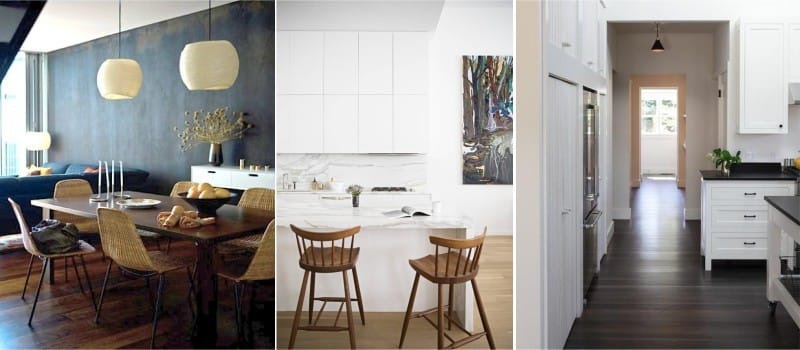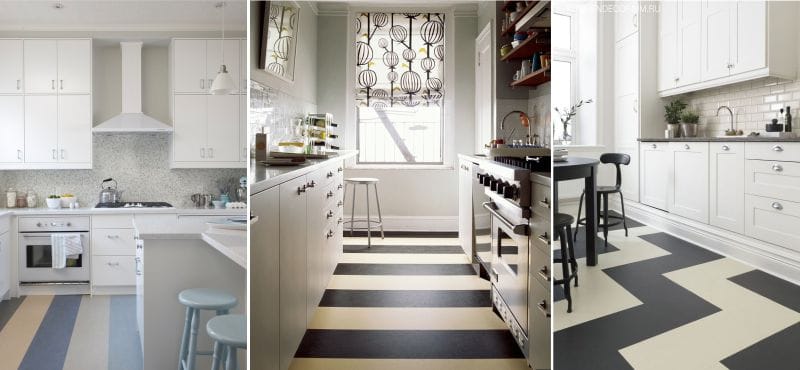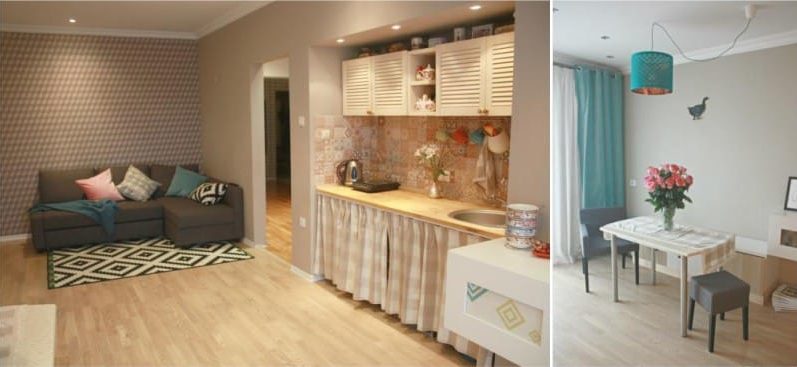Linoleum is a floor covering of 6 layers of polymeric material, which is produced in the form of rolls.

In fact, linoleum is also called wall covering, completely natural and even produced by type of tile covering, but in this article we will look at the familiar PVC coating and learn how to choose the best linoleum for the kitchen.
How is linoleum worse / better than tile and laminate?
There are a number of reasons explaining why linoleum should be put on the floor in the kitchen, not tile or laminate. Among the main advantages of the material:
- Durability (linoleum 32 and 33 classes have a service life of 8 to 15 years);
- High wear resistance - withstands falling sharp and heavy objects, suitable for apartments with pets;
- Ease of care - to wash the PVC coating is very simple. In addition, unlike laminate and floorboard, it is easy to wash off spilled beet juice or red wine;
- It has heat and sound insulation properties, it is much warmer than laminate and tile, in addition, this material can be called the most silent;
- A wide range of designer - PVC coating can perfectly imitate a wooden floor with both color and embossed texture. Today, quality linoleum is not immediately distinguished from the floorboard or laminate. But wooden texture is not the only possible design, because there are options for the floor under the tile, leather or stone. The most popular colors and textures can be later on the photo of linoleum in the interior of the kitchen;

- Cost - depending on the manufacturer, type and class of wear resistance, the price varies from 150 to 800 rubles. for 1 square. m;
In the conditions of the kitchen, a material of at least 350 rubles per square meter is acceptable
- Linoleum can be easily, quickly and cleanly put your own hands, unlike any other flooring;
- Also, you can relatively inexpensively entrust installation to specialists - professional laying of tile, laminate, parquet and pouring a self-leveling floor is much more expensive, and putting it on your hands is more difficult and troublesome;
- Dismantling the floor of linoleum is very simple, it can also be made with your own hands, without a partner and special tools.

And now about the shortcomings:
- Heavy furniture may cause dents;
- Material artificiality - natural materials are always more valuable and more beautiful;
- If linoleum is bought at a temperature below + 10 ° C, then you can not roll out the roll immediately after purchase. It is necessary to let it lie down (rolled up) at room temperature (not lower than +15 C) for 1-2 days. Otherwise, it may crack;
- If you lay it wrong and not on a leveled base, then it can "float" and this will wear out faster;
- When joining several pieces of linoleum will be visible seam, but if you dock the pattern correctly, the junction will not be so noticeable.
5 myths about linoleum
- "Sex smells bad at first" - modern high-quality material has almost no odor and does not emit harmful substances.
- “Over time, dark / light trails appear on the surface in places that are most often used for walking.”- yes, indeed, on the surface of a household type of linoleum, after several years of operation, rubbing may appear due to frequent washing of the floor with aggressive household chemicals, walking in black rubber shoes, etc. But for coverages of 31, 32, 33 class, laid on an even basis, this defect is not peculiar.
- "The thicker the linoleum, the longer it will last" - not quite the right statement, because now wear-resistant coatings of commercial and semi-commercial type are thicker than household coatings. But the thickness of the transparency (protective layer) plays a big role, it must be at least 0.5 mm.
- "Stitches can break up" - for linoleum, a new generation, this problem is no longer relevant.
- "At high humidity under the linoleum mold forms" - the formation of fungus under PVC coating, lay correctly, - is impossible, because it is made entirely of artificial material, and the upper protective layer absolutely does not pass water. If there was a flood, you just need to bend the wet part of the linoleum and let it dry. In case you are often flooded by neighbors or pipes are leaking, it is better to choose a tile.
Go to the store - what you need to know?

So, how to choose linoleum for the kitchen?
Before going to the store you need to make measurements. Measure:
- Maximum floor width;
- Maximum floor length;
- The length and width of the niches and doorways;
For each measurement you need to add 8 cm (80 mm), so you take into account the irregularities.
Also, you need to decide on the type of wear resistance, abrasion level and type of coating.

Linoleum is divided into 2 groups:
- Homogeneous, that is, single-layer coating - its thickness is up to 3 mm. Not very popular due to the lack of many colors.
- Heterogeneous, multi-layered, up to 6 mm thick. In the structure of such linoleum several layers, from durable fiberglass to PVC, plus decorative and protective layers.
The main quality criteria are:
- The abrasion class (according to the European certificate EN660-1) is defined as the degree of wear of the upper protective layer after the impact of an abrasive wheel on certain modes. Four groups are distinguished: the strongest T (0.08 mm), weakly abraded P (0.15 mm), moderately abraded M (0.3 mm), F - strongly abraded (up to 0.6 mm).
- Wear resistance level. The European classification EN685 in this case provides for the marking of two numbers. The first one indicates the type of room, and the second one shows the level of maximum load on the floor. These are the same classes of wear resistance, dividing the coating into domestic, semi-commercial and commercial. For the kitchen, it will be right to choose a coating of at least grade 23, but optimally - 32-33.
Each subsequent increase in position leads to the fact that the floor becomes more expensive about 1.5 times.
In addition, the dimensions of the material are different - it is supplied in standard rolls with a width of 1.5-4 meters. If you choose a roll width that matches the kitchen settings, then as a result you can make the floor without seams.
The choice of design and photo in the interior of the kitchen
On the floor of the kitchen you can put linoleum with a matte or glossy top layer. It is more expedient to use gloss, because it is easier to clean.
The range includes:
- Classic beige brown imitation wood;
- Imitation natural stone or ceramic tiles;
- High-quality mosaic or parquet images;
- Fantastic textures, patterns;
- Single color coatings.
Quality linoleum, imitating parquet, will look incredibly reliable. "Wooden" linoleum will fit into any kitchen.



Dust, chips, stains are visible on the dark and too light floor. In terms of ease of care, it is better to choose brown and gray tones. In addition, dark color hides the space, so it can be put only in large and bright kitchens.

The drawing of the aged board on the floor is now in fashion and will not leave it for a long time. This floor will decorate the kitchen in a rustic style, classic, Scandinavian and loft (scroll to the right).
For classic interiors, a reliable imitation of ceramics will be the best solution.

Plain linoleum cold or contrast colors suitable for high-tech kitchens and minimalism.

If the footage allows, you can choose the solution of the brightest colors, with three-dimensional geometric patterns - it will be appropriate in the styles of eclecticism, pop art, Scandinavian.

In order to visually enlarge the space of the kitchen, light linoleum of cold tones is laid on the floor.
In this case, remember the well-known rule: the transverse strips visually expand the kitchen, and the vertical stripes extend it.

Warm colors of the floor will make the kitchen more comfortable, and bright contrasting decisions will add to the room dynamism.
Rules laying linoleum

Putting linoleum on the floor with your own hands is so simple that even a beginner can handle it. After dismantling the old floor you can get to work.

The main difficulty is the alignment of the subfloor and the installation of cracks (after which all construction debris and dust are removed very carefully), but this stage is necessary for installing any kind of floor covering.
If you plan to level the base with your own hands, then a self-leveling self-leveling compound is best suited for this. Of course, the laying of linoleum do not produce until the screed is completely dry.
So, how to lay a linoleum with your own hands?
After the base is ready, the roll is rolled into the room (at a temperature above + 15 ° C) and left to “acclimatize” for 1-2 days. After leveling the linoleum, it is cut. To do it yourself, you need a very sharp construction knife. It is cut easily and smoothly, thanks to the markings on the reverse side up and down. However, when trimming, it will be necessary to leave a technological gap between the coating and the wall - 5 mm. This is necessary for the free movement of the material during shrinkage.
Now you need to fix the linoleum. For strength, it is glued over the entire area.
Express method: you can glue it only on the perimeter with double-sided tape. After that, the material is carefully pressed plinths.
In this video, you can learn more about how to choose linoleum for the kitchen and how to lay it on your glue with your own hands:
- Gender is relative: choose flooring for the kitchen
- Self-leveling kitchen floor
- Cork flooring - 99% ideal floor covering for the kitchen
- Floorboard in the kitchen - all the pros and cons
- Everything about laminate flooring in the kitchen - from choice to installation
- Porcelain tiles in the kitchen - 99% perfect floor









 (Rate the material! Already voted:18 average rating: 4,72 from 5)
(Rate the material! Already voted:18 average rating: 4,72 from 5)
Linoleum is a good option for the kitchen, as it is easy to clean liquids and debris from the floor, and even the owner of the kitchen can cope with linoleum, without hiring repairmen.
Other options are not considered. Bed "Tarket" independently. Washes well. does not scratch. Tile on the wall fits almost any color.
I like linoleum because of its practicality and durability. Therefore, in the kitchen we laid linoleum with imitation tiles. It turned out well that it is not even clear that this is not a tile.
For me, the decisive factors in favor of linoleum in the kitchen were its cheapness relative to other materials and ease of cleaning. Chose brown tones - for the kitchen that is necessary.
The cheapest and most convenient kitchen flooring material is linoleum. It creeps easily, is easy to clean, does not slip. With modern technology linoleum wear-resistant and any color. Finally, linoleum is easily repaired with scuffs.
Very valuable advice. Now I will know how to visually increase the size of the kitchen. Linoleum, indeed, the best option flooring.
In order to save money, we laid linoleum in the hall with a pattern imitating laminate.If you don’t look at it very closely, it looks pretty decent. So for a low-budget repair fits perfectly.
Despite those all the disadvantages that linoleum has, the advantages are much greater, and they are more weighty than the disadvantages. The main plus is the price and ease of installation.
We already had linoleum and tile in the kitchen. Laminate in-law. So I have something to compare with. Linoleum is simple and cheap, very practical. Everything else requires more care. And on the tile we are generally cold.
Expensive linoleum outwardly is not easy to distinguish from the laminate. For the kitchen, I believe that linoleum is the best option, since it is not afraid of moisture. I would like to add that when buying linoleum with a complex pattern, it is necessary to calculate its cutting in advance for the best fit of the pattern.
Good quality linoleum is an excellent choice for the kitchen - it washes well, it's hard to damage. Even if you rearrange the furniture, traces of it on good linoleum are not visible!
Well, the artificiality of the material is only in the matter of price. Since there is already a natural one - Marmoleum.
Good linoleum is not much cheaper than the average tile, in the kitchen he laid tile and linoleum. In the area of cooking they laid tiles (there are no traces left when knives and other sharp objects fall), and in the dining area linoleum (it is more pleasant to walk barefoot). I consider this combination the best choice.
Very useful article. I think that linoleum still has more advantages than disadvantages, but drawbacks, in most cases - external ... We laid linoleum in the hall, after some time decided to make a rearrangement (furniture is just heavy). Began to move - and linoleum is really crushed. Moreover - for some reason, he swelled for some reason. I sin on workers who did repairs, maybe they didn’t take into account what ...
But in general, it is really very convenient and, most importantly, a moderately cheap version of floor finishing.
I covered the kitchen floor in a circle. Started with laminate. I didn’t like it, she was afraid of water, all neighbors heard about a fallen object, and so on. Tile laid on the floor godfather. If the plate fell, then just broke. And walking on the stone floor barefoot is somehow uncomfortable. Now I laid linoleum. A single sheet without seams. The color of the laminate in the rest of the apartment. I still do not see any flaws.
Linoleum is a budget option and it has a lot of advantages. With ease they themselves bedded him in the kitchen - beautiful, easy to clean, warm and cheap. Thanks to this article, I clearly saw how you can choose linoleum for the interior.
When we did in the apartment repair, there was a question about the floor covering. Dumalai take laminate
but acquaintances persuaded us to linoleum, since it is more practical.
Really choosing linoleum did not regret a drop. We have a little
a child, he can pour out the water and go little by little before reaching
pot. Laminate would have long been covered.